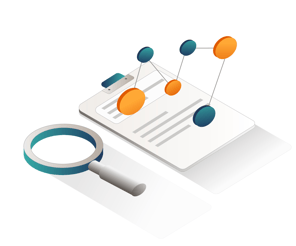In today's digital age, businesses face the challenge of reaching and engaging with their target audience amidst a sea of content and noise. One effective way to cut through the clutter and reach your ideal customers is through customer segmentation. By dividing your audience into distinct groups based on shared characteristics, you can better tailor your marketing efforts to meet their needs and preferences, increasing the likelihood of conversion and retention.
Here's a step-by-step guide on how to identify and target your ideal audience through customer segmentation:
Defining Your Business Goals

Before segmenting your audience, you must clearly understand your business goals. This will help you tailor your segmentation strategy to meet your needs. As a digital publisher, your goal may be to increase subscriber retention, grow your user base, or increase revenue from advertising. This will help you tailor your segmentation strategy to meet your needs. For example, you should segment your audience based on their past read behaviour and preferences to improve subscriptions. If your goal is to expand your reach, you may want to segment your audience based on their interests and demographics to understand better who your potential new readers are.
Gathering Data

Data is the foundation of effective customer segmentation. You can gather data on your audience through various sources, including customer surveys, social media analytics, website analytics, and customer relationship management (CRM) tools. The key is to gather data on both demographic and psychographic factors so that you can create segments that are both meaningful and actionable.
Segmenting Your Audience

Once you have gathered data on your audience, it's time to segment them into distinct groups based on shared characteristics. This can include demographic segments such as age, gender, and location and psychographic segments such as interests, values, and attitudes. The key is to create meaningful and actionable segments to tailor your marketing efforts to each group.
Developing Personas
To better understand each segment, you can build customer personas that represent the typical characteristics of each group. This can include information such as their goals, challenges, and preferences. By developing personas, you can tailor your marketing efforts to meet each segment's needs better. For example, if you have identified a segment of business professionals who consume news primarily on their mobile devices, you can develop optimised marketing materials for mobile viewing.
Tailoring Your Marketing Efforts

Once you have developed customer personas, it's time to tailor your marketing efforts to each segment. This can include everything from the messaging and tone of your marketing materials to the channels and platforms you use to reach each group. By tailoring your marketing efforts to each segment, you can increase the likelihood of conversion and retention. For example, if you have identified a segment of older customers who prefer to receive information by mail, you can tailor your marketing efforts to include direct mail campaigns.
Effective customer segmentation can have a significant impact on your business. According to a study by Bain & Company, businesses that use customer segmentation report an average revenue increase of 10%, with some companies seeing an increase of up to 30%.
One company that has seen significant success through customer segmentation is Spotify. By segmenting its audience into distinct groups based on their listening behaviour and preferences, Spotify can tailor their music recommendations and personalised playlists to each user. As a result, they have grown to over 365 million monthly active users, with 165 million paid subscribers. Digital publishing is no different. You can gain a lot by understanding and segmenting your readers' preferences. It's essential to cater to your audience and give them the content they want. This not only keeps them engaged but also helps you to build a loyal following. So, take the time to analyse your readers and create targeted content that speaks to them directly. You'll be amazed at the positive feedback you receive and the growth of your digital publishing efforts.
 Why should you contact a subscription provider for assistance with segmentation strategy? While customer segmentation is a powerful tool but can be complex and time-consuming. As a digital publisher, you may need more resources or expertise to segment your audience on your own effectively. This is where a subscription provider can be a valuable partner. A subscription provider can help you to gather and analyse data, develop customer personas, and tailor your marketing efforts to each segment. By working with a subscription provider, you can save time and resources while maximising the effectiveness of your segmentation strategy.
Why should you contact a subscription provider for assistance with segmentation strategy? While customer segmentation is a powerful tool but can be complex and time-consuming. As a digital publisher, you may need more resources or expertise to segment your audience on your own effectively. This is where a subscription provider can be a valuable partner. A subscription provider can help you to gather and analyse data, develop customer personas, and tailor your marketing efforts to each segment. By working with a subscription provider, you can save time and resources while maximising the effectiveness of your segmentation strategy.
In conclusion, effective customer segmentation is a powerful tool for subscription providers in the digital news reader market. By gathering data on your audience, segmenting them into distinct groups, developing personas, and tailoring your marketing efforts and content to each segment, you can increase subscriber retention, grow your user base, and increase revenue from advertising. The key is to create meaningful and actionable segments so that you can create targeted marketing campaigns and content that speak directly to the needs and preferences of each group.
About Evolok
Evolok helps online publishers increase their revenues and drive audience engagement using Evolok’s end-to-end SaaS solution, which provides paywalls, subscription management, user segmentation and identity management. Evolok delivers a selective ecosystem to drive user engagement and mobilization. Evolok helps its clients increase readership and revenue by engaging and personalizing content, protecting valuable content through paywalls, utilizing login and social data to know customers incrementally, and targeting products and pricing to boost subscriptions.
If you need any help with your subscription journey or are thinking of migrating your publishing business to the subscription business model, contact us today.
